Card Weaving � 1996
Adapted from Earth Knack:
Stone Age Skills for the 21st Century
Text and Illustrations by Bart & Robin Blankenship
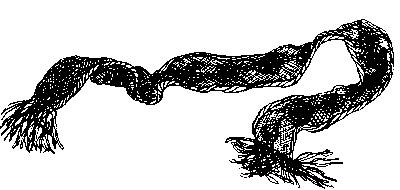
This is an ancient technique for making a strong strap quickly. A five foot strap can be woven in a couple of hours. You don't need a loom, only cards with holes in the corners, and about two hundred feet of cord. If you're cording it yourself, you need to get busy! The cards can be made of cardboard, leather, rawhide, bark, wood, fired clay, or even stone. Although not necessary, it can be very helpful to have a shuttle to hold the weft (the cord woven back and forth). You can use any type of netting shuttle. A very quick and easy shuttle to make is the spilt stick shuttle. Take a green stick that is about 8" long and 1 1/2" thick. Gently split each end about two to three inches. Wrap cord through the splits until they are full.
We are going to give you directions to weave a strap that is strong enough for pack straps, basket handles, tumplines, and saddle cinches. If you do a pattern like the one we are giving directions for, than it will be lovely enough for curtain ties, belts and other uses too. We will give you a pattern that takes 12 cards and 2 colors of cord. If you don't want a pattern in the strap, just use all one color cord. This strap will be five feet long, but you can make it any length you want.
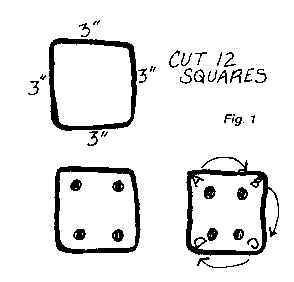 First make the cards (Figure 1)
First make the cards (Figure 1)
Cut three inch squares out of your chosen card material. The thinner the cards are, the easier they are to rotate in the weaving. Make a hole in each of the four corners of all 12 cards. Don't do this too close to the corner so you have room to label the cards in a manner that you can see the label as you work with the cards.
Labeling the cards is very important. Do it just this way. Lay all the cards in front of you and write the letter A in the top left-hand corner of each card. Now write B through D clockwise in each corner. When the letters are on the cards then number them 1 through 12 along the edge of the card between the letters D and A. Place all the labeled cards in a stack so the numbers are on the top, facing you, and so all the letters are aligned. Card #1 will be on top of the stack, closest to you, and Card #12 will be on the bottom (Figure 2).
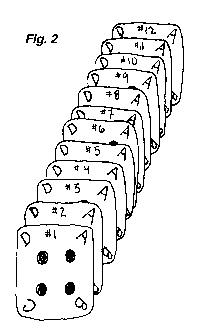 For this example, you will need 48, six foot long, warp cords, the cords that go through the cards. Twenty-two cords will be of a lighter color and twenty-six cords will be of a darker color. We will use "lighter" and "darker" in our threading for a pattern description, so it will be helpful if you cut them this way. Lay the cords on the floor.
For this example, you will need 48, six foot long, warp cords, the cords that go through the cards. Twenty-two cords will be of a lighter color and twenty-six cords will be of a darker color. We will use "lighter" and "darker" in our threading for a pattern description, so it will be helpful if you cut them this way. Lay the cords on the floor.
You are now ready to thread the cards
For clarity, in explaining how to thread the cards, the side with the letters and numbers is called the front side. The blank side is called the back. Hold the stack of cards in your hand with all the numbers on top. Turn the fronts of the cards to the left, numbers still on top, so you are holding the stack sideways. Cards 1 through 6 will be threaded from their back side and out their front. Cards 7 through 12 will be threaded from their front side and out their back (Figure 3). Having half of the cords threaded from back to front and the other half of the cards threaded from front to back gives a balanced strap, one that will not want to twist when it is finished.
 We have cut cords of lighter and darker color to make our favorite pattern that will give diamonds, arrowheads, X's, and other symmetric shapes depending on how you turn the cards. To get this pattern you need to thread lighter and darker cords through the cards in the particular order described below. If you don't care about the pattern, you can thread these lighter and darker cords any way you want to through the holes of each card to get a random pattern. If you have all the same color cord, thread the cards as de scribed above and skip the threading directions for making the pattern. Remember, whatever you decide about pat tern, each card must be threaded with all four cords going from the front to the back or from the back to the front, in order for that card to be able to rotate properly.
We have cut cords of lighter and darker color to make our favorite pattern that will give diamonds, arrowheads, X's, and other symmetric shapes depending on how you turn the cards. To get this pattern you need to thread lighter and darker cords through the cards in the particular order described below. If you don't care about the pattern, you can thread these lighter and darker cords any way you want to through the holes of each card to get a random pattern. If you have all the same color cord, thread the cards as de scribed above and skip the threading directions for making the pattern. Remember, whatever you decide about pat tern, each card must be threaded with all four cords going from the front to the back or from the back to the front, in order for that card to be able to rotate properly.
The Threading Pattern
Remember to thread 1 through 6 from back to front Figure 4.
Card 1: All holes are threaded with a dark color.
Card 2: All holes threaded with light color.
Card 3: A with dark, the rest light.
Card 4: A and B dark, C and D light.
Card 5: A, B, and C dark, D light.
Card 6: B light, A, C and D dark.
Remember from now on you are threading from front to back.
Card 7: B light, A, C and D dark.
Card 8: A, B, and C dark, D light.
Card 9: A and B dark, C and D light.
Card 10: A dark, B, C, and D light.
Card 11: All light.
Card 12: All dark.
After you thread each card, tie the ends of the four cords together in a knot. Push the card almost up to this knot. You should have almost six feet of cord between you and the card.
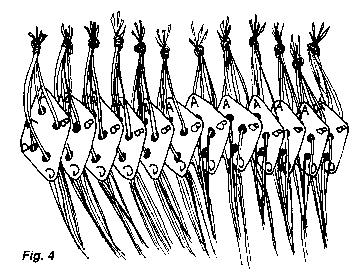 Take the knotted ends of all the cords and tie them all together with a strong piece of string around the bottom of all the knots. Tie this strong string to something solid at about eye level. Check your cards. Make sure they are all turned up the same way. This will insure the least amount of tangle. All the cards must be positioned with holes A and D on top, D in the left corner, and A in the right corner and the numbers center. Gently pull all the cards away from their knotted ends, toward you, to untangle the warp threads. It helps to have another pair of hands to untangle the cords as you pull the cards toward you. Pull the cards until they are one foot from the end of the cords. Comb this last foot with your fingers.
Take the knotted ends of all the cords and tie them all together with a strong piece of string around the bottom of all the knots. Tie this strong string to something solid at about eye level. Check your cards. Make sure they are all turned up the same way. This will insure the least amount of tangle. All the cards must be positioned with holes A and D on top, D in the left corner, and A in the right corner and the numbers center. Gently pull all the cards away from their knotted ends, toward you, to untangle the warp threads. It helps to have another pair of hands to untangle the cords as you pull the cards toward you. Pull the cards until they are one foot from the end of the cords. Comb this last foot with your fingers.
Pull the ends of all the cords together, under equal tension and tie the ends in an overhand knot. You can get the tension really equal if you slide the cards up and down a few times while pulling back on the ends before you tie the knot. Tie a strong string around the top of this knot and tie this end to another heavy object, a chair will work, or your belt. Whatever you choose, make sure it holds the warp cords under good tension. This makes it easier to weave.
You're ready to start.
Check your cards. Have the cards positioned with D in the left top corner, the number, center top, and A in the right top corner. This is the starting position for our pattern. Are they all the same? Good. Take all of the cards in your hands and turn them, all at once, one quarter turn away from you so holes A and B are on top. Slide the cards back and forth until the warp splits into two sets of cords. This split is where you will run the shuttle through the warp. When the split opens, use your hands to firmly pull the separating warps apart. Now pass the shuttle through this opening. Leave a foot of the end of the shuttle cord hanging out to the side. Turn the cards another quarter turn away from you. Holes B and C will be on top. Remember to slide the cards back and forth after rotating them in order to open up the split in the warp. Again, firmly pull this opening apart and pass the shuttle through. From now on, pull the weft tightly across the warp after each pass of the shuttle . If the weft is too loose you'll have big floppy loops on the edges of your strap. Turn the cards another quarter turn away. Holes C and D will be on top. Slide the cards, split the warp, and pass the shuttle through. Turn the cards an other quarter turn away. Holes D and A will be on top again, with the numbers in the center. You have done a full rotation. You should begin to see an arrowhead with a light center pointing away from you.
Turn the cards toward you. If you always turn the cards away from you, the warp cords will get so twisted, that you can't rotate the cards. With the cord we have used, we can do about sixteen quarter turns, or four full card rotations in one direction or the other before we have to turn the other way.
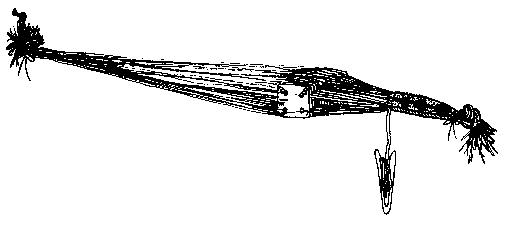 The next four quarter turns toward you will give you another arrow head pointing in the opposite direction of the one you just completed. Together they will actually look like a large X. In this pattern this is the way you get X's. If you want two arrowheads pointing the same direction, then turn the cards eight quarter turns away from you when you start. If you want diamonds, begin the weave with four quarter turns toward you, and then do four quarter turns away from you. (This is two arrowheads with their base ends connected). These aren't your only choices with this pat tern. You can rotate the cards 5 or 6 or however many times you want in any one direction, and then reverse as many times in the opposite direction as you want. If you don't care about a sequential pattern, then you don't need to keep track of your turns forward or back. You can randomly turn the cards and do all the experimenting you want. Just remember to reverse them once in a while so the warps don't tangle.
The next four quarter turns toward you will give you another arrow head pointing in the opposite direction of the one you just completed. Together they will actually look like a large X. In this pattern this is the way you get X's. If you want two arrowheads pointing the same direction, then turn the cards eight quarter turns away from you when you start. If you want diamonds, begin the weave with four quarter turns toward you, and then do four quarter turns away from you. (This is two arrowheads with their base ends connected). These aren't your only choices with this pat tern. You can rotate the cards 5 or 6 or however many times you want in any one direction, and then reverse as many times in the opposite direction as you want. If you don't care about a sequential pattern, then you don't need to keep track of your turns forward or back. You can randomly turn the cards and do all the experimenting you want. Just remember to reverse them once in a while so the warps don't tangle.
The other side of the strap is also forming a pattern, sometimes more intriguing than the one you are watching develop. Remember, if the warp knot is tied to your belt. you will have to take up the new weave and retie it to your belt as you work up the strap. As you near the far end of the warp, you will run out of room to rotate the cards. When this happens, you are finished. Untie the upper knot, and re move the cards. Your strap is ready to use. You can braid or sew the ends to keep them from unraveling.
Robin Blankenship teaches classes through Earth Knack in Crestone, Colorado. Card Weaving was adapted from their book, Earth Knack: Stone Age Skills for the 21st Century, and published in the Bulletin of Primitive Technology, Issue #11, Spring 1996.
Return to the SPT Articles, Books & Back Issues Home Page










 First make the cards (Figure 1)
First make the cards (Figure 1)  For this example, you will need 48, six foot long, warp cords, the cords that go through the cards. Twenty-two cords will be of a lighter color and twenty-six cords will be of a darker color. We will use "lighter" and "darker" in our threading for a pattern description, so it will be helpful if you cut them this way. Lay the cords on the floor.
For this example, you will need 48, six foot long, warp cords, the cords that go through the cards. Twenty-two cords will be of a lighter color and twenty-six cords will be of a darker color. We will use "lighter" and "darker" in our threading for a pattern description, so it will be helpful if you cut them this way. Lay the cords on the floor.  We have cut cords of lighter and darker color to make our favorite pattern that will give diamonds, arrowheads, X's, and other symmetric shapes depending on how you turn the cards. To get this pattern you need to thread lighter and darker cords through the cards in the particular order described below. If you don't care about the pattern, you can thread these lighter and darker cords any way you want to through the holes of each card to get a random pattern. If you have all the same color cord, thread the cards as de scribed above and skip the threading directions for making the pattern. Remember, whatever you decide about pat tern, each card must be threaded with all four cords going from the front to the back or from the back to the front, in order for that card to be able to rotate properly.
We have cut cords of lighter and darker color to make our favorite pattern that will give diamonds, arrowheads, X's, and other symmetric shapes depending on how you turn the cards. To get this pattern you need to thread lighter and darker cords through the cards in the particular order described below. If you don't care about the pattern, you can thread these lighter and darker cords any way you want to through the holes of each card to get a random pattern. If you have all the same color cord, thread the cards as de scribed above and skip the threading directions for making the pattern. Remember, whatever you decide about pat tern, each card must be threaded with all four cords going from the front to the back or from the back to the front, in order for that card to be able to rotate properly.  Take the knotted ends of all the cords and tie them all together with a strong piece of string around the bottom of all the knots. Tie this strong string to something solid at about eye level. Check your cards. Make sure they are all turned up the same way. This will insure the least amount of tangle. All the cards must be positioned with holes A and D on top, D in the left corner, and A in the right corner and the numbers center. Gently pull all the cards away from their knotted ends, toward you, to untangle the warp threads. It helps to have another pair of hands to untangle the cords as you pull the cards toward you. Pull the cards until they are one foot from the end of the cords. Comb this last foot with your fingers.
Take the knotted ends of all the cords and tie them all together with a strong piece of string around the bottom of all the knots. Tie this strong string to something solid at about eye level. Check your cards. Make sure they are all turned up the same way. This will insure the least amount of tangle. All the cards must be positioned with holes A and D on top, D in the left corner, and A in the right corner and the numbers center. Gently pull all the cards away from their knotted ends, toward you, to untangle the warp threads. It helps to have another pair of hands to untangle the cords as you pull the cards toward you. Pull the cards until they are one foot from the end of the cords. Comb this last foot with your fingers.  The next four quarter turns toward you will give you another arrow head pointing in the opposite direction of the one you just completed. Together they will actually look like a large X. In this pattern this is the way you get X's. If you want two arrowheads pointing the same direction, then turn the cards eight quarter turns away from you when you start. If you want diamonds, begin the weave with four quarter turns toward you, and then do four quarter turns away from you. (This is two arrowheads with their base ends connected). These aren't your only choices with this pat tern. You can rotate the cards 5 or 6 or however many times you want in any one direction, and then reverse as many times in the opposite direction as you want. If you don't care about a sequential pattern, then you don't need to keep track of your turns forward or back. You can randomly turn the cards and do all the experimenting you want. Just remember to reverse them once in a while so the warps don't tangle.
The next four quarter turns toward you will give you another arrow head pointing in the opposite direction of the one you just completed. Together they will actually look like a large X. In this pattern this is the way you get X's. If you want two arrowheads pointing the same direction, then turn the cards eight quarter turns away from you when you start. If you want diamonds, begin the weave with four quarter turns toward you, and then do four quarter turns away from you. (This is two arrowheads with their base ends connected). These aren't your only choices with this pat tern. You can rotate the cards 5 or 6 or however many times you want in any one direction, and then reverse as many times in the opposite direction as you want. If you don't care about a sequential pattern, then you don't need to keep track of your turns forward or back. You can randomly turn the cards and do all the experimenting you want. Just remember to reverse them once in a while so the warps don't tangle.